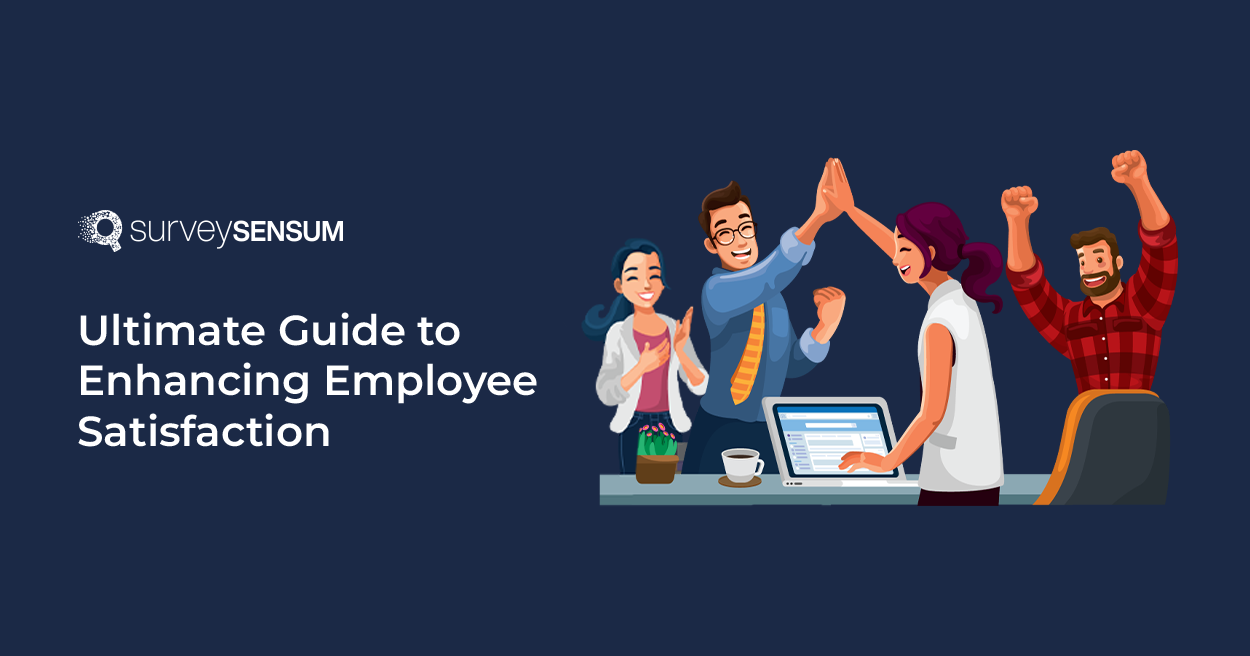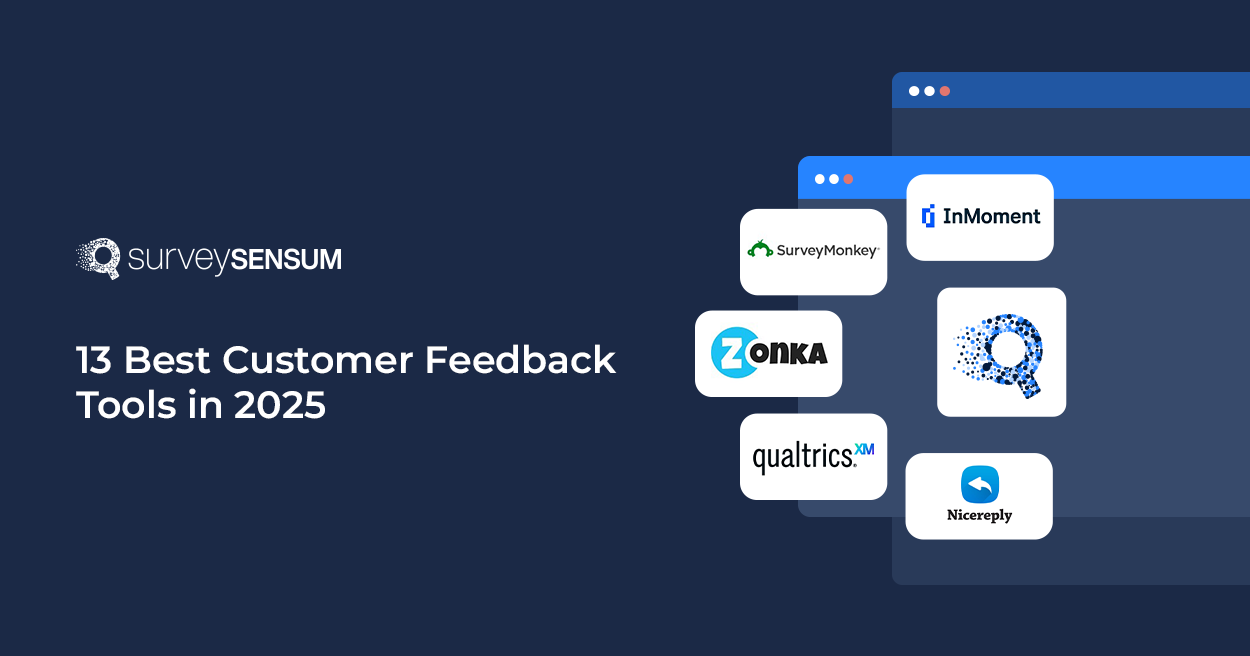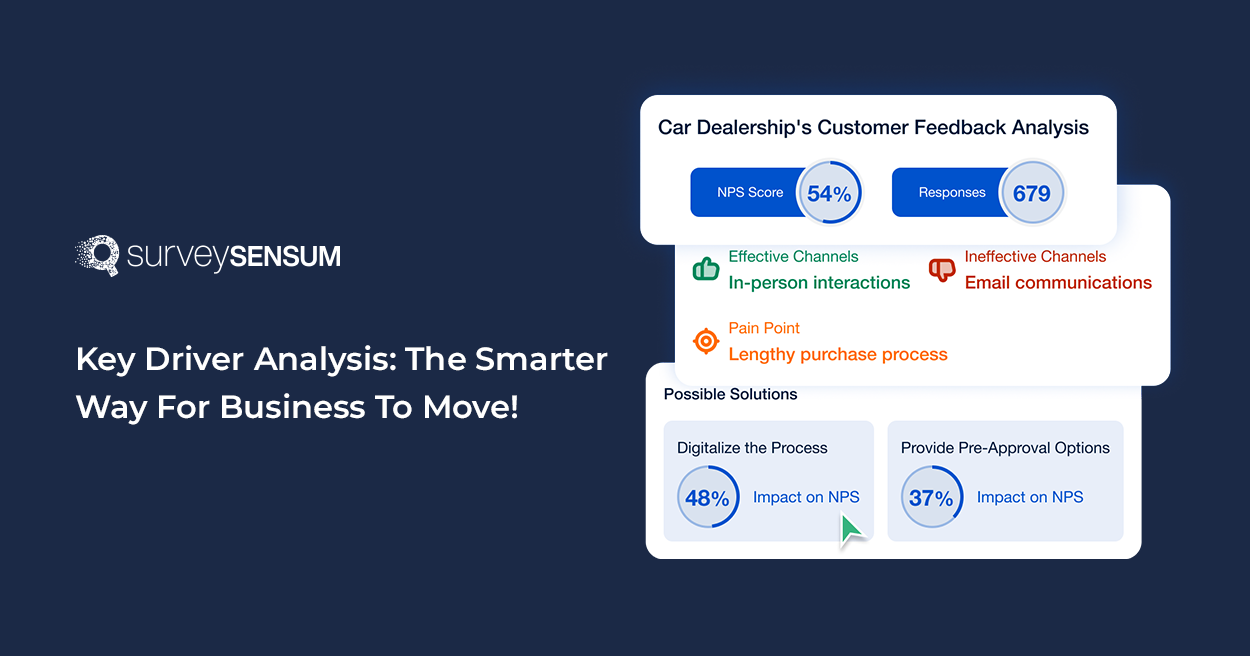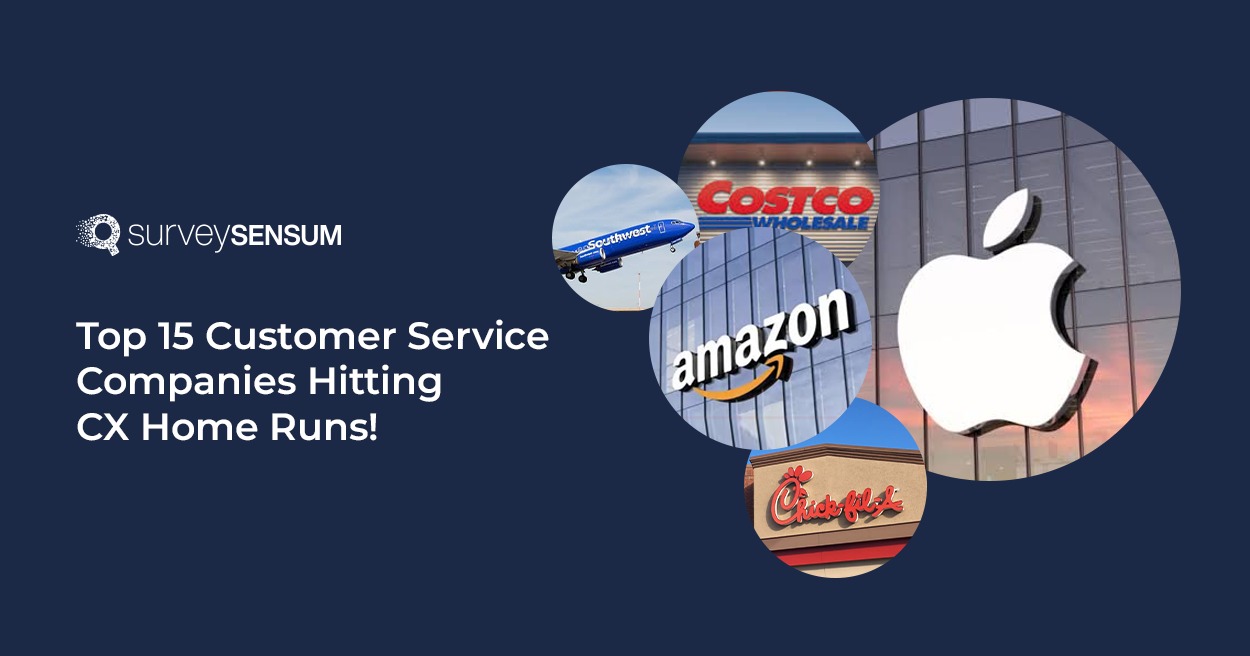
At the heart of any successful organization lies its workforce, and the key to unlocking the full potential lies in ensuring your employee satisfaction and well-being.
In fact, happy and satisfied employees are 13% more productive than unhappy and dissatisfied employees. Not only that, employee satisfaction has a great impact on your customer loyalty because companies with an employee engagement program reported enjoying 233% greater customer loyalty.
However, employee satisfaction isn’t just about creating happy employees – it encompasses a complex interplay of factors, including job fulfillment, work-life balance, opportunities for growth, recognition, and a supportive company culture.
Picture this: You step into Office A, and immediately, the air is charged with positivity and collaboration. Your team members are buzzing with energy, and you feel a surge of creativity and motivation. Contrast this with Office B, where your entrance is met with your manager’s reprimand for a minor mistake, colleagues who are uncooperative, and unnecessarily extended working hours. Where would you prefer to work?
Undoubtedly, Office A holds the allure. But why? Because when you are satisfied, you are more engaged, productive, and likely to contribute meaningfully to the organization’s goals.
But more often than not, companies tend to overlook employee satisfaction in the pursuit of the company’s goals without realizing they are dependent on each other.
But how do you improve it for your company – BY LISTENING TO THE VOICE OF YOUR EMPLOYEES (with the help of a robust employee feedback tool, of course!)
So, with this blog, we will dive deep into strategies, best practices, and insights aimed at creating a thriving and fulfilling work environment for employees and boosting employee experience at all levels. Whether you’re an HR professional, a team leader, or an executive seeking to optimize employee engagement and retention, this blog will provide valuable insights and actionable steps to help you achieve your objectives.
But first, let’s start by talking about the definition of employee satisfaction, in detail.
What is Employee Satisfaction?
Imagine your team members waking up in the morning, eager to tackle the day ahead because they genuinely enjoy what they do. That’s the magic of employee satisfaction.
Employee satisfaction refers to the level of contentment, fulfillment, and happiness that employees experience in their jobs and workplaces. It encompasses various factors such as job security, compensation, benefits, work-life balance, opportunities for growth and development, relationships with colleagues and supervisors, and organizational culture.
But wait, don’t get it confused with employee engagement, they are both different concepts.
Employee Satisfaction vs. Employee Engagement
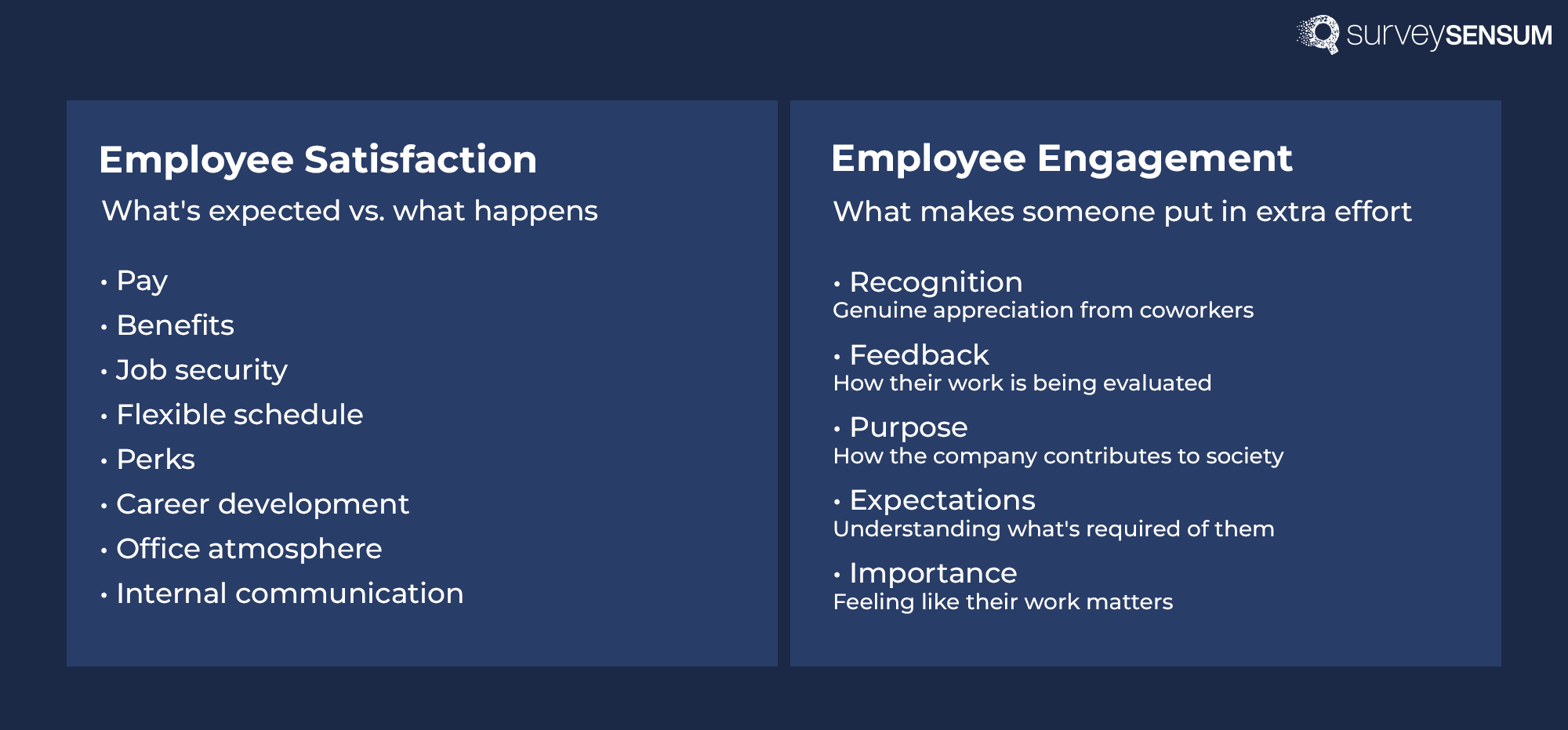
Employee satisfaction and employee engagement are related concepts but are not exactly the same.
While employee satisfaction is an important component of employee engagement, engagement encompasses a broader spectrum of attitudes and behaviors.
An organization can have satisfied employees who are not fully engaged, meaning they may be content with their jobs but not actively contributing to the organization’s success. Similarly, engaged employees are likely to be satisfied, but their level of commitment and enthusiasm go beyond mere contentment, leading to higher performance and productivity, which can be effectively tracked using performance management software.
Therefore, both concepts are important and companies should invest in creating both satisfied and engaged employees.
Here are the major differences between these two concepts.
| Employee Satisfaction | Employee Engagement |
| It primarily focuses on how content or fulfilled employees feel in their roles and within the organization. | It focuses on the emotional commitment and level of involvement that employees have toward their work and the organization’s goals. |
| It involves factors such as compensation, benefits, work-life balance, job security, and relationships with colleagues and supervisors. | It involves factors such as feeling valued, having opportunities for growth, being recognized, and having a clear understanding of how the work contributes to the overall goals of the organization. |
So yes, it’s time that you start engaging with your employees and boosting their satisfaction and loyalty to the organization. But first, gauge their satisfaction and engagement levels with employee engagement surveys.
Now, that the confusion is cleared up, let’s understand why employee satisfaction is important.
Why is Employee Satisfaction Important?
Employee satisfaction is important for several reasons:
1. Increased Employee Retention:
Happy employees are 87% less likely to leave their organization.
When your employees are happy and satisfied they are more likely to stay with you for a longer period of time.
2. Decreased Turnover Rates:
The cost of replacing an individual employee can range from 0.5 to 2 times the employee’s annual salary.
High turnover rates can be costly for businesses in terms of recruitment, training, and lost productivity. By maintaining a satisfied workforce, organizations can reduce turnover and retain valuable talent.
3. Increased Productivity:
Companies with high satisfaction rates witness 31% more productivity and 37% & higher sales.
Satisfied employees are more motivated and engaged in their work. They are more productive, contribute innovative ideas, and deliver higher-quality work. This increased productivity can directly impact the organization’s bottom line and competitiveness.
4. Improved Customer Satisfaction:
According to a Gallup study, companies with satisfied and engaged employees have 20% more sales.
Satisfied employees are more likely to go above and beyond to provide better customer service to their customers. They are more engaged in their interactions with customers, leading to improved customer satisfaction and loyalty. Positive customer experiences can enhance the organization’s reputation and lead to repeat business and referrals.
5. Improved Organizational Culture:
According to research by the Journal of Management, “Impact of Organization Culture on Employee’s Job Satisfaction” 46.66% strongly agree and 43.3% agree regarding the efficiency of organizational culture in providing employee satisfaction.
A positive work environment where employees feel valued, respected, and supported fosters a culture of collaboration, creativity, and teamwork. This, in turn, can attract top talent and enhance the organization’s reputation as an employer of choice.
6. Improved Employee Health and Well-being:
According to Forbes, 70% of professionals say that companies that promote mental well-being have higher job satisfaction scores.
Job satisfaction is linked to overall well-being and mental health. Satisfied employees experience lower levels of stress and are generally healthier, both physically and mentally. Organizations that prioritize employee satisfaction demonstrate a commitment to their employees’ well-being, which can lead to greater job satisfaction and loyalty. This is particularly crucial in industries such as medical billing services, where employee morale directly impacts efficiency and accuracy. Satisfied employees are more likely to benefit greatly from work-life balance initiatives in the company. Simple steps like including wellness programs or benefits such as portioned meal plans can help employees maintain a healthier lifestyle and feel valued by their organization.
For example, Microsoft prioritizes employee health and well-being through its “Microsoft Cares” program, which offers comprehensive healthcare benefits, mental health resources, and wellness programs. They provide a “work from anywhere” policy and also encourage employees to take regular breaks and participate in physical activities.
So yes, it is important to boost employee satisfaction. But first thing first – measure their satisfaction and engagement levels with employee engagement surveys.
Overall, investing in employee satisfaction is not only beneficial for employees themselves but also for the organization as a whole. Let’s now discuss the factors that impact employee satisfaction.
4 Factors that Drive Employee Satisfaction
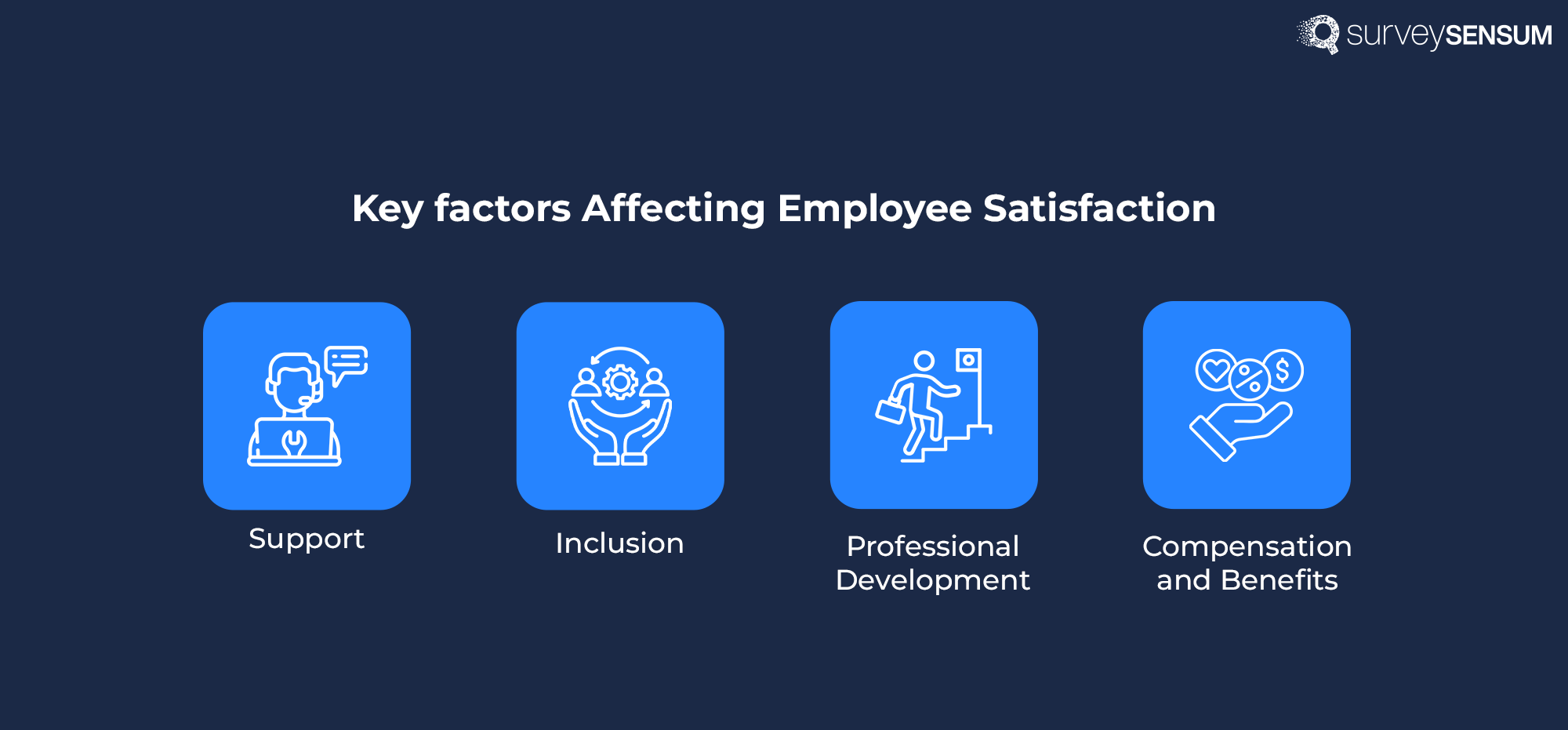
Employee satisfaction is influenced by a variety of factors that contribute to their overall experience and engagement within the workplace. Here’s a breakdown of how each of the factors you mentioned can drive employee satisfaction:
1. Support: The Safety Net of Success
When employees feel supported, they can navigate their responsibilities with confidence, knowing they’re not alone in their journey.
This support can come in various forms, such as managerial support, resources to perform their job effectively, and access to mentorship or counseling programs. When employees feel supported, they are more likely to be satisfied with their work environment and feel confident in their abilities to perform their tasks.
Brand Example: Patagonia is renowned for its supportive work culture, providing employees with extensive resources for personal and professional growth. They offer mentorship programs, wellness initiatives, and counseling services to ensure employees feel supported in all aspects of their lives.
2. Inclusion: Where Everyone’s Voice Matters
When employees feel included, they are more likely to engage with their work, collaborate with colleagues, and contribute positively to the organization. Inclusion involves creating employee recognition programs for all employees to participate, contribute ideas, and be recognized for their contributions, leading to higher levels of satisfaction and commitment of satisfaction and commitment
Brand Example: At Pixar Animation Studios, the concept of inclusion is deeply ingrained in their culture. Employees from diverse backgrounds are encouraged to contribute their unique perspectives and ideas. For instance, during the making of the movie “Coco,” Pixar collaborated closely with Mexican cultural consultants and animators to ensure an authentic representation of Mexican culture, fostering a sense of inclusion and belonging among employees.
3. Professional Development: Fueling Growth and Adventure
When employees have the chance to learn and develop new skills, they feel more engaged and motivated in their roles. Offering opportunities for professional growth and development is crucial for employee satisfaction. This can include training programs, skill-building workshops, access to educational resources, and opportunities for career advancement.
Additionally, investing in employees’ professional development signals that the organization is committed to their long-term success, which can enhance satisfaction and loyalty.
Brand Example: Google is renowned for its emphasis on employee development. They offer a plethora of learning opportunities, from in-house training programs to tuition reimbursement for external courses. Google’s “20% time” policy allows employees to dedicate a portion of their workweek to pursue projects outside their core responsibilities, fostering creativity and continuous learning.
4. Compensation and Benefits: The Fuel for Flourishing
When employees feel fairly compensated and have access to valuable benefits, they are more likely to feel satisfied with their jobs and remain loyal to the organization.
Fair and competitive compensation, along with comprehensive benefits packages, are fundamental factors in employee satisfaction. Compensation should reflect employees’ contributions, skills, and market value, while benefits such as healthcare, retirement plans, and paid time off contribute to their overall well-being and quality of life.
Brand Example: Costco is celebrated for its commitment to fair compensation and comprehensive employee benefits. Despite being a retail giant, Costco pays its employees significantly higher wages than competitors, along with generous benefits like healthcare and retirement plans. This approach has led to high employee satisfaction and loyalty, with many employees staying with the company for decades.
By addressing these factors and creating a supportive, inclusive, and growth-oriented work environment, organizations can enhance employee satisfaction, leading to improved performance, retention, and overall success.
So, pay attention to these important factors that drive employee satisfaction. Listen to the voice of your employees and understand their needs and pain points by launching employee satisfaction surveys with SurveySensum.
Now, that we know the importance and factors influencing employee satisfaction, let’s now talk about how to measure employee satisfaction.
How to Measure Employee Satisfaction?
Measuring employee satisfaction is essential for organizations to gauge the overall well-being and engagement of their workforce.
And how do you do that? – With EMPLOYEE SURVEYS.
Now, there are two types of employee surveys that help you measure employee satisfaction:
- Employee satisfaction surveys
- Employee net promoter score surveys (eNPS)
1. Employee Satisfaction Surveys:

Employee satisfaction surveys are structured questionnaires designed to gather feedback from employees about various aspects of their job, workplace environment, and overall satisfaction. These surveys typically include a mix of quantitative and qualitative questions:
- Quantitative Questions: These questions are typically multiple-choice or scaled responses that allow employees to rate their satisfaction on specific aspects such as job satisfaction, manager support, team collaboration, and work-life balance.
For example:
→ On a scale of 1 to 5, how satisfied are you with your current workload?
→How likely are you to recommend this company as a great place to work to a friend or colleague?
- Qualitative Questions: These questions are open-ended and encourage employees to provide detailed feedback, suggestions, and comments about their experiences and concerns.
For example:
→What aspects of your job do you find most fulfilling?
→ Please share any suggestions for improving team communication and collaboration.
2. eNPS:

It is a metric used to measure employee loyalty and advocacy within an organization. The eNPS is derived from the well-known NPS methodology, which is commonly used in customer satisfaction surveys.
The eNPS question typically asks:
→On a scale of 0 to 10, how likely are you to recommend [Company Name] as a great place to work to a friend or colleague?
Launch employee experience with SurveySensum in just under 10 minutes!
How to Improve Employee Satisfaction?
Here are the 9 strategies to improve employee satisfaction:
1. Focus on Creating Meaningful Work
According to McKinsey & Company, when employees find meaningful work their performance improves by 33%, they are 75% more committed and 49% less likely to leave.
- Communicate your organization’s mission, vision, and values to your employees, allowing them to understand the purpose behind their work and feel a sense of fulfillment.
- Foster a culture that recognizes and celebrates employees’ contributions and achievements.
- Offer skill development opportunities that allow employees to take on new challenges, develop skills, and grow professionally.
2. Involve Employees in Decision-Making
- Involve employees in decisions that affect their daily routines or tasks, demonstrating trust in their opinions and fostering a sense of ownership and commitment.
- Gather feedback from employees on relevant policies, procedures, and initiatives.
- Provide training and resources to empower employees to participate effectively in decision-making.
- Communicate the rationale behind decisions and how employee input influenced the outcome.
- Recognize and reward employees for their contributions to decision-making processes.
3. Create Career Development Roadmaps
A study by the Robert Walters Group found that 69% of millennials said career progression keeps them engaged at work.
- Provide employees with clear pathways for career advancement and skill development. Identify key skills and competencies required for advancement in various roles.
- Provide opportunities for job rotation, stretch assignments, and promotions based on merit and performance.
- Regularly review and update career development plans to align with employees’ aspirations.
4. Encourage Open Communication and Feedback
Did you know that 70% of employees believe that regular feedback and criticism from managers enhances their job performance?
- Provide timely and constructive feedback to employees on their work and contributions. Encourage two-way communication between managers and employees, allowing for dialogue, questions, and suggestions.
- Implement regular check-ins or one-on-one meetings to discuss progress, goals, and development opportunities.
- Create a feedback-friendly environment where employees feel valued and engaged in their work.
5. Offer Competitive Pay and Perks
- Ensure that compensation and benefits packages are competitive and aligned with industry standards to attract and retain top talent.
- Recognize the value of employees’ contributions by offering fair and competitive pay and perks. This may include salary increases, bonuses, and incentives based on performance and market benchmarks.
- Comprehensive benefits packages, including health insurance, retirement plans, and paid time off, are also important.
6. Personalize experiences
According to the Zendesk EX trends report, 87% of EX professionals stated that personalization increases employee satisfaction.
- Recognize and appreciate the unique talents, preferences, and needs of individual employees by personalizing their work experiences.
- Tailor job roles, assignments, and responsibilities to fit employees’ skills, interests, and career goals such as one may be thinking about to start a career in IT.
- Provide opportunities for professional development and growth that align with employees’ aspirations.
- Offer flexibility in work arrangements, schedules, and workspaces to accommodate individual needs and preferences.
7. Celebrate Employee Milestones
- Acknowledge and celebrate the achievements, milestones, and contributions of employees to foster a culture of recognition and appreciation.
- Host recognition events, ceremonies, or awards programs to honor outstanding achievements. Publicly acknowledge and praise employees’ contributions through newsletters, emails, or social media.
- Provide personalized tokens of appreciation, such as awards, certificates, or gift cards.
8. Encourage Work-Life Balance
According to a study conducted by the IBM Institute for Business Value, 51% of employees consider work-life balance as the top factor influencing engagement within an organization.
- Promote work-life balance to support employees’ overall well-being and enhance job satisfaction.
- Offer flexible work arrangements, such as telecommuting, flexible hours, or compressed workweeks.
- Provide resources and support for managing stress, maintaining wellness, and achieving work-life harmony.
- Set clear expectations and boundaries around work hours, workload, and availability. Encourage employees to take breaks, vacations, and time off to recharge and rejuvenate.
9. Set up Flexible Work Schedules
A recent McKinsey survey revealed that 87% of employees choose flexible working models when given the opportunity.
- Allow employees to adjust their work hours or location based on their individual circumstances and preferences.
- Provide technology and tools to support remote work, collaboration, and productivity. Try to find platforms where you can use features such as desk booking, project management, time tracking and etc.
- Establish clear guidelines and expectations for remote work, including communication protocols and performance metrics.
- Encourage managers and teams to embrace flexibility and adaptability in their work practices and routines.
By implementing these strategies, organizations can create a supportive, inclusive, and engaging work environment that enhances employee satisfaction, retention, and overall success.
Conclusion
Employee satisfaction is not merely a metric to track – it is the cornerstone of organizational success.
When employees feel valued, supported, and fulfilled in their roles, they become more engaged, motivated, and committed to contributing their best efforts. By prioritizing employee satisfaction through strategies etc organizations can create a culture that retains top talent, drives innovation, and achieves long-term success. Investing in employee satisfaction is not just beneficial for individuals; it is essential for building resilient, thriving, and future-ready organizations.
But the most important and noteworthy strategy is to regularly listen to the voice of your customers and to do that you need a robust employee feedback tool like SurveySensum. This tool will help you design effective employee experience surveys like eNPS, 360-degree feedback, etc. Not only that, but with this tool you can manage and analyze the feedback with automation, saving a ton of manual labor, and derive insightful and actionable steps to improve your weak areas!






